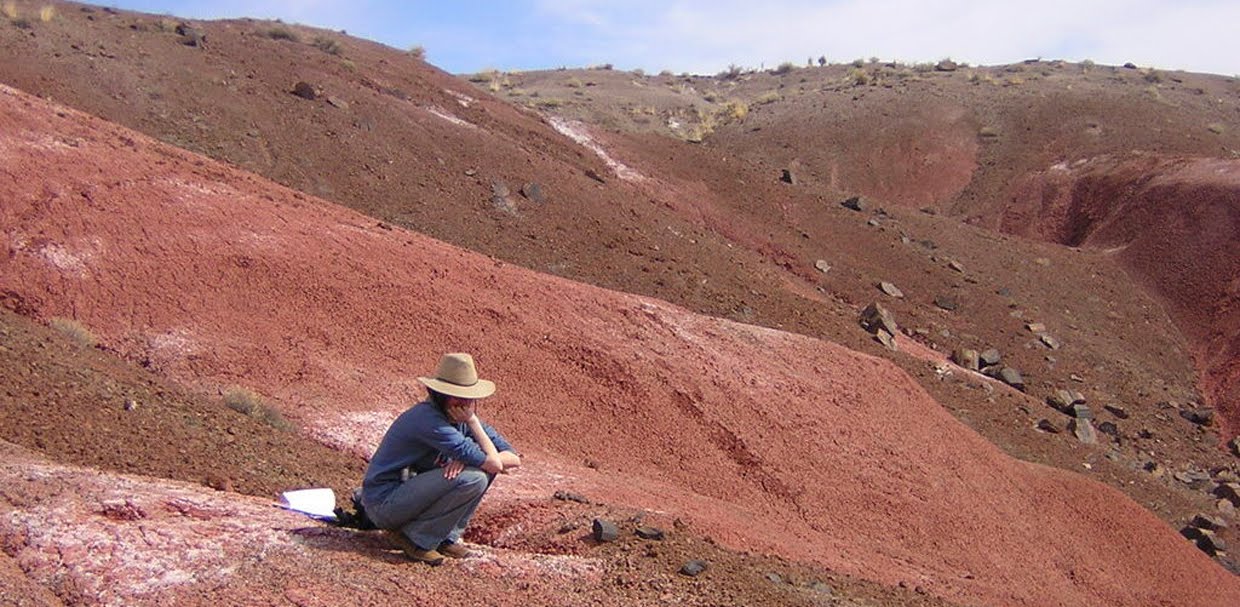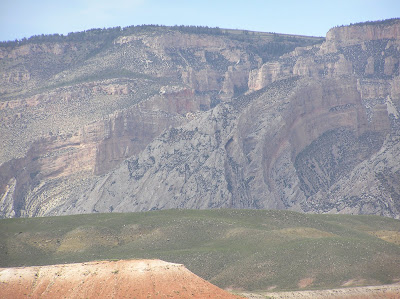 This hillside sign reads "World's Largest Mineral Hot Springs," with arrows pointing to the base of the hill. At the hill's base, we find:
This hillside sign reads "World's Largest Mineral Hot Springs," with arrows pointing to the base of the hill. At the hill's base, we find:
This hot spring did not appear very large, but I am from back east, and perhaps I don't know very much about hot springs. I did feel the water, and I am happy to confirm that it was "hot," but I am uncertain on the criteria by which Thermopolis ranks itself. To be fair, there were a few other springs in town, although each of them seemed to have even less water coming out than this one. The "terraced pool walk" was also a bit optimistic:
 ...although the evidence does seem to indicate that, at some time, there was a lot of water coming over the edge here. Perhaps it was an off day for the springs. Anyway, there is a very nice bouncy bridge that goes out over the river, from which you can see where mineral-laden water has cascaded:
...although the evidence does seem to indicate that, at some time, there was a lot of water coming over the edge here. Perhaps it was an off day for the springs. Anyway, there is a very nice bouncy bridge that goes out over the river, from which you can see where mineral-laden water has cascaded: An up-close view of some of the rocks:
An up-close view of some of the rocks:

These fantastic forms were created by calcium carbonate (calcite, or limestone) and calcium sulfate (gypsum) precipitating out of the water after it exited the earth. The rock they form is called travertine. There is enough sulfur in the water to make it smell positively disgusting when the wind blows a whiff your way; I couldn't breathe through my nose if I was very close to a spring.
For some reason, the locals have piped some of the spring water into fountains, which also stink terribly, and which also precipitate minerals and get half-beautiful, half-disgusting algae growing on them:
 Here is one small fountain with minerals and algae. Here is a larger one:
Here is one small fountain with minerals and algae. Here is a larger one: This structure was started only 106 years ago. I think it's nice, but if I were going to get creative with geologic processes I think I'd have chosen, say, a sculpture of a shaven Bob Marley and let the water come out of the top of that. Or at least a buffalo. Speaking of buffalo:
This structure was started only 106 years ago. I think it's nice, but if I were going to get creative with geologic processes I think I'd have chosen, say, a sculpture of a shaven Bob Marley and let the water come out of the top of that. Or at least a buffalo. Speaking of buffalo: This sign excited me. It seemed to imply that there were, in fact, buffalo in the buffalo pasture. However, I hiked around it for an hour or so and did not see any buffalo. Considering it was almost 90 degrees out, perhaps they'd all taken off for the pub.
This sign excited me. It seemed to imply that there were, in fact, buffalo in the buffalo pasture. However, I hiked around it for an hour or so and did not see any buffalo. Considering it was almost 90 degrees out, perhaps they'd all taken off for the pub.Despite its being an obvious tourist area there is not a huge amount to do in Thermopolis, nor were there many visitors there... nor are there many citizens, in fact, something around 3,000... so at least some of our group ended up going to a Mexican restaurant in town, wandering back, finding another portion of the group that was on their way to the Mexican restaurant, going back to the Mexican restaurant, and then coming back to the vans. I spent a good amount of my four-hour visit in the Wyoming Dinosaur Center.
 This small museum had some very high-quality fossils and casts of all kinds of dinosaurs and other life forms, and the information was well-presented and up-to-date. I think a family might spend only half an hour there, so I'm not sure it would be worth the $10 a person admission, but it was a bargain for me at the student rate of $3.50. They also have tours of their dig sites and dig-for-a-day programs which I think might be fun for visitors. If you ever happen to go to Thermopolis.
This small museum had some very high-quality fossils and casts of all kinds of dinosaurs and other life forms, and the information was well-presented and up-to-date. I think a family might spend only half an hour there, so I'm not sure it would be worth the $10 a person admission, but it was a bargain for me at the student rate of $3.50. They also have tours of their dig sites and dig-for-a-day programs which I think might be fun for visitors. If you ever happen to go to Thermopolis. This is a coelophysis from Ghost Ranch, where I spent a weekend excavating last summer. (If you'll remember, I didn't find anything like this.) I have a high level of appreciation for the amount of work involved in preparing a fossil to get it to look like this. It takes hundreds or thousands of man-hours. That can obviously get very expensive (and might explain the admission fee), but thankfully many people are interested in dinosaurs and I expect this facility had a volunteer program allowing skilled amateurs to help. They had a prep lab there and you could look in the windows and see things (though no one was working when I was there). I was a bit jealous at the quality of the bone... much of the stuff they were working on was Cretaceous... as opposed to the Triassic stuff I worked on last summer, which often looked like it belonged to something called an explodosaurus. Remember, the Triassic stuff had been in the ground 100 million years longer!
This is a coelophysis from Ghost Ranch, where I spent a weekend excavating last summer. (If you'll remember, I didn't find anything like this.) I have a high level of appreciation for the amount of work involved in preparing a fossil to get it to look like this. It takes hundreds or thousands of man-hours. That can obviously get very expensive (and might explain the admission fee), but thankfully many people are interested in dinosaurs and I expect this facility had a volunteer program allowing skilled amateurs to help. They had a prep lab there and you could look in the windows and see things (though no one was working when I was there). I was a bit jealous at the quality of the bone... much of the stuff they were working on was Cretaceous... as opposed to the Triassic stuff I worked on last summer, which often looked like it belonged to something called an explodosaurus. Remember, the Triassic stuff had been in the ground 100 million years longer!After the museum and my hike, I finally decided to try the hot springs.
 This is the State of Wyoming Bath House. Does Rhode Island have a state bath house? I don't think so! Here you could soak for 20 minutes for free. I was uncertain as to the value of the experience... as I mentioned, it was nearly 90 degrees out, and in any case just sitting in some water for 20 minutes hardly even seemed worth changing into my bathing suit for... but it turned out to be great.
This is the State of Wyoming Bath House. Does Rhode Island have a state bath house? I don't think so! Here you could soak for 20 minutes for free. I was uncertain as to the value of the experience... as I mentioned, it was nearly 90 degrees out, and in any case just sitting in some water for 20 minutes hardly even seemed worth changing into my bathing suit for... but it turned out to be great. They have piped the water into a couple of shallow pools, and somehow lowered its temperature to 104 degrees, which is sort of nicely warm, as opposed to the wince-inducing 134 degrees where the springs come out of the ground. The water smells only very faintly of sulfur and I have to say that the smell is actually nicer than the usual chlorine pool smell. I found it very relaxing and just sort of sat there all 20 minutes while some old guys on the other side of the pool talked about trucking. It wasn't too hot, I was in the shade and there was a little breeze. The water is milky blue... you can't see more than a foot into it... and the pool had a killer limestone bathtub ring. If I lived in Thermopolis I am sure I would come here often. After a 20-minute soak, you can't return for 2 hours, but there are a couple other for-pay water parks nearby where you can soak as much as you like. They have water slides too.
They have piped the water into a couple of shallow pools, and somehow lowered its temperature to 104 degrees, which is sort of nicely warm, as opposed to the wince-inducing 134 degrees where the springs come out of the ground. The water smells only very faintly of sulfur and I have to say that the smell is actually nicer than the usual chlorine pool smell. I found it very relaxing and just sort of sat there all 20 minutes while some old guys on the other side of the pool talked about trucking. It wasn't too hot, I was in the shade and there was a little breeze. The water is milky blue... you can't see more than a foot into it... and the pool had a killer limestone bathtub ring. If I lived in Thermopolis I am sure I would come here often. After a 20-minute soak, you can't return for 2 hours, but there are a couple other for-pay water parks nearby where you can soak as much as you like. They have water slides too.My roommates have just come back to camp... today was our actual free day, Sunday, and some of the group went to Cody to see a movie and go shopping. I hung out in camp, napped in my hammock, and researched grad schools on the internet. It is the cook's day off too, but there were leftovers in the fridge from all our meals this week... pork chops, chicken fajitas, spaghetti, pancakes and bacon, et cetera. I made a giant taco salad for lunch and I think I will have pork chops and applesauce for supper.
I think tomorrow we may be doing something with paleosols, which will be nice. Nice because I already know some things about them. Things are often more interesting when you already know something about them than when you're just being introduced. We will see.





































